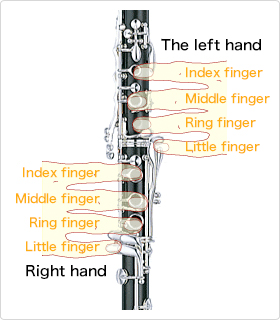The Structure of the Clarinet
From C up to high G
The clarinet has a range of four octaves!
How is the clarinet able to cover such a wide register, when it does not appear to be such a long instrument?
For example, if you blow hard into a recorder, the notes that are produced are an octave higher than when you play normally, so if you play C and blow hard, a high C is produced.
On the clarinet, playing C and blowing hard produces a high G.
The clarinet is the only wind instrument that can reach such high notes. With more tone holes than the recorder and an extended register, the clarinet takes full advantage of this property.
The sound of the clarinet
*These are the notes produced when the manner in which the clarinet is blown is varied without changing the fingering, in order to verify the properties of the tube. When the instrument is actually played, the fingering changes for each different note.
An instrument with many holes
On a recorder, the hole that is covered by the index finger is the topmost hole.
On the clarinet, there are additional holes above this hole. Since there are holes in places that make them difficult to close using the fingers, keys to cover these holes are attached to the instrument. There are also keys for the holes that cannot be reached with the little finger.
The clarinet also has its own distinctive fingering. Multiple different notes can also be produced on the trombone and trumpet by changing the way in which the instrument is blown while maintaining the same fingering; on the clarinet, however, the fingering for each note is different.

Finger positions on the clarinet
Musical Instrument Guide:Clarinet Contents
Structure
How the Instrument is Made
Choosing an Instrument
Trivia
- "I Broke My Clarinet" is a French folk song
- Inspiring composers
- In Italy, a single B♭ clarinet
- At one time, most clarinets were made of boxwood
- In vogue in the 1900s-the metal clarinet
- A transparent clarinet?
- Famous clarinet works: concertos
- Famous clarinet works: chamber music
- What is the relationship between hertz and cents?
